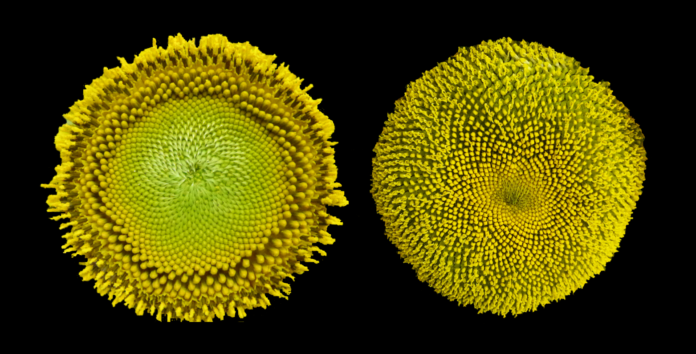Researchers find that controlled bloom patterns attract bees and improve pollination
By LILLY ACKERMAN — science@theaggie.org
A new study from researchers in UC Davis’s Department of Plant Biology found that sunflower blooms are coordinated by their circadian clocks, opening different sections of florets in a ring pattern. This makes them optimal for pollination by bees, which are their main pollinator.
Sunflowers are well known for their ability to turn and face the sun throughout the day. Their circadian clock, which is the natural cycle that they follow over every 24-hour period, controls this famous movement, but it also helps them maximize pollination by controlling how they bloom.
Dr. Stacey Harmer, a senior author on the study and professor of plant biology at UC Davis, says that sunflowers’ heads have a disk made up of thousands of individual flowers, or florets. When it comes time to release and receive pollen, sunflowers’ florets open in a coordinated pattern that attracts bees during a timeframe called anthesis.
“When they’re in the middle of [anthesis], you’ll see that it [the blooming] goes from the outside of the disk to the inside of the disk,” Harmer said. “And you see sort of a target shape; you have rings — not spirals — of florets at different developmental stages[…]It’s like making a really great show for the pollinating bees.”
The disk forms a target shape by opening rings at different times; the outer ring will open one day, followed by a different inner ring the next day. The entire disk of florets opens in the span of approximately one week.
Each floret opens to release pollen just after dawn. This is coordinated heavily with when bee pollinators are most active and allows for maximum pollination.
“This coordinated mass release of floral rewards at predictable times of day likely promotes pollinator visits and plant reproductive success,” the study reads.
Interestingly, the same ring of florets will release pollen in its male form one day and then be in its female form to receive pollen the next day.
“They’re also super interesting plants because an individual floret is male one day, making pollen, releasing it, and the next day, it’s female, so it can receive pollen,” Harmer said. “And that’s a way they promote outcrossing between flowers.”
Outcrossing is the transfer of pollen from one flower to a genetically different one. This is a beneficial process for the entire sunflower population as it increases genetic diversity, which improves the population’s resilience. The ability to adapt and respond to the environment is especially important amid a changing climate.
The timing of pollen release that sunflowers utilize depends upon light availability as well as the circadian clock, according to the study. Previous work has shown that temperature also affects its timing.
This means that changes in climate can present mismatches between pollinator activity, which is governed mainly by their circadian clock, and sunflower anthesis, which responds to the environment. It is therefore crucial that plants’ circadian clocks are understood, so that appropriate measures can be taken to address mismatches detrimental to both bee and sunflower populations due to reduced pollination.
“I think it is important to understand this in terms of agriculture in the face of climate change,” Harmer said. “I think this is going to be a potentially useful breeding target as breeders think about how to promote successful pollination.”
Written by: Lilly Ackerman — science@theaggie.org




